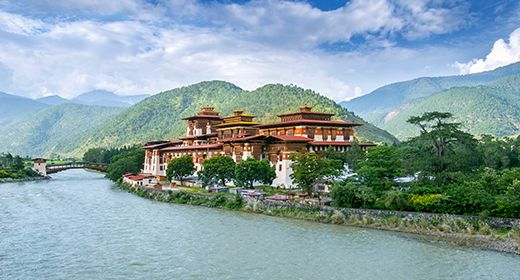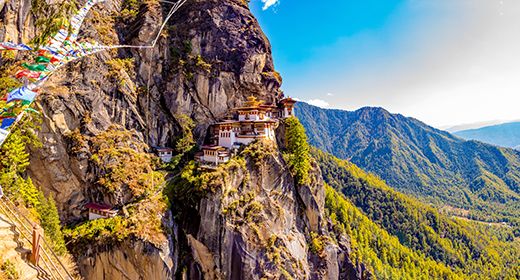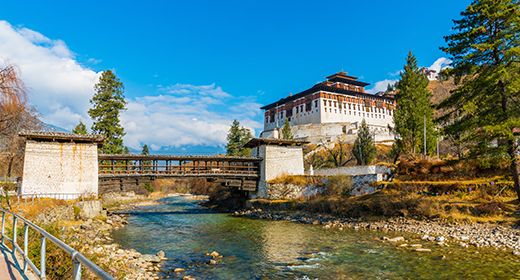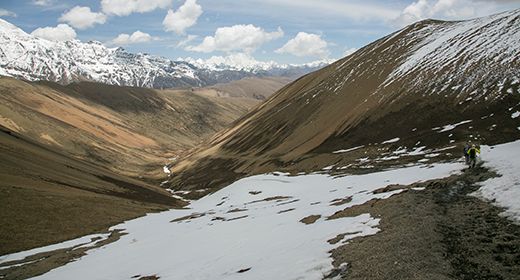Bhutan
Highlights
- Picturesque scenery, including the Himalayan Mountains, verdant valleys, dense forests, pristine rivers, and pastures with grazing cattle and yaks.
- Buddhist temples, dzongs, forest monasteries, and religious monuments.
- Thimpu, the capital city, for excellent hotels, restaurants, cafes, museums, and shopping.
- Tibetan Buddhism dominates the culture and the local villagers still dress in traditional attire and are friendly and welcoming.
- Wide assortment of high-altitude trekking experiences from an casual single day hike to difficult climbs lasting over three weeks.
- Religious dance festivals, known as 'tsechu', which are held inside dzongs.
The Kingdom of Bhutan is unlike any other Asian destination. It is a small, landlocked country situated in the Eastern Himalayan Mountains between China and India. Tibetan Buddhism dominates the culture and even the government. It feels much like stepping back in time, as traditional, medieval-looking dress is the norm amongst locals. The people here are welcoming and charmingly friendly and the natural scenery is breathtaking to behold.
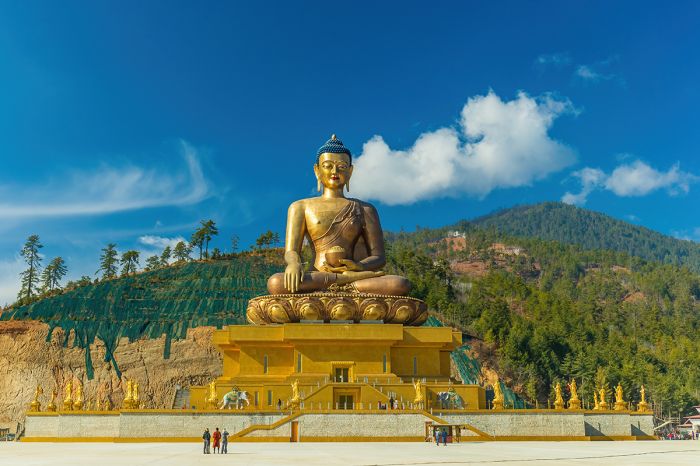
Buddha Dordenma statue in Thimphu, Bhutan.
The country has adopted a high-value, low-value tourism model, and for those who can afford it, the advantages are well worth the price. The experience of traveling in Bhutan is almost pleasure, with almost zero stress nor hassle involved. There are old-world monasteries, spectacular temples, pristine forests, exquisitely clean rivers, lush valleys, and extraordinary mountains.
The country consists of three major regions: Western Bhutan, Central Bhutan, and Eastern Bhutan. Read below for details on each.
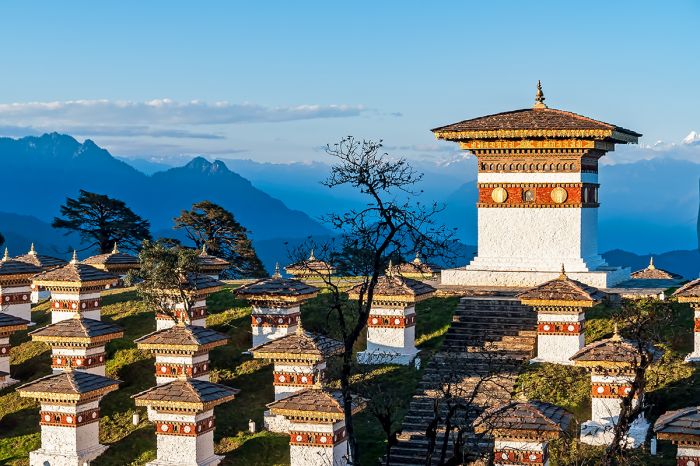
Dochula Pass in the Himalayas. In this pass, 108 memorial chortens known as "Druk Wangyal Chortens" were ordered built by Ashi Dorji Wangmo Wangchuk, the eldest Queen Mother and first wife of former King Jigme Singye Wangchuck.
Western Bhutan
Thimpu, Bhutan's charming capital city and only substantial urban center, is located in Western Bhutan and is where almost all visits begin. The city is situated along the Wang Chhu River. The city has lost some of its medieval feel, thanks mostly to an abundance of multi-story concrete buildings, but the mix of both ancient and modern provides an interesting contrast.
Thimpu has plenty of good and excellent hotels, numerous restaurants and cafes, museums, and small shops selling a mix of everything traditional and modern, from monks' robes to stylish street wear. Thimpu claims to be one of only two capital cities in the world without a single traffic light; instead, white-gloved traffic police direct vehicles at the busiest intersections.
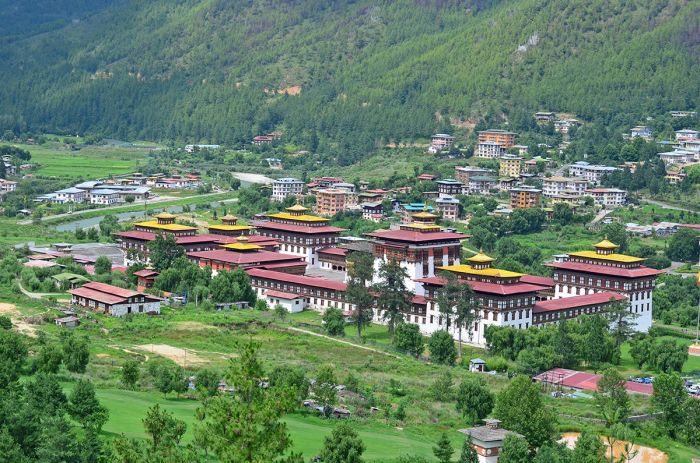
Tashichho Dzongis a Buddhist monastery and fortress in Bhutan's capital city of Thimphu, on the western bank of the Wang Chhu River.
Be sure to visit Thimpu's Centenary Market, where local farmers sell all kinds of vegetables, fish, pork, cheese and other dairy products, chiles, wild honey, leg of yak, spices, rice and other grains, and much more. There is also a very good crafts market, selling Dhaka bowls made from wood, prayer beads, traditional garments, and other art. Negotiating is acceptable.
Beyond Thimpu, Western Bhutan offers beautiful temples and dzongs (fortress-like monasteries), incredible scenery in five parallel valleys, and the country's most popular festivals. Prayer flags can be seen fluttering from bridges and rooftops, the locals dress mostly in traditional attire, there are stupas and chortens, and dzongs to be encountered one ofter another along the roads. The scenery is also quite breathtaking.
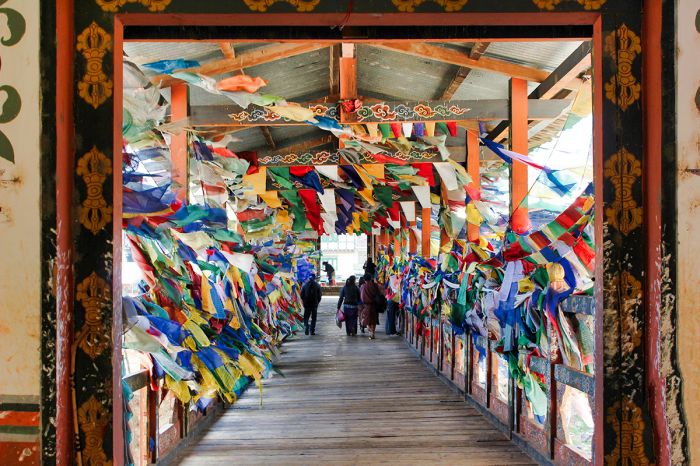
Buddhist prayer flags at a monastery in Thimpu, Bhutan.
Three hours' drive northeast of Thimpu is the town of Punakha, the former capital of Bhutan and the seat of government for over 300 years (until 1955). The gorgeous Punakha Dzong sits at the junction of two major rivers, and is arguably Bhutan's most majestic manmade structures.
Besides a visit to Punakha Dzong, the town has excellent accommodation and plenty of activities, including good hiking, river rafting, and mountain-biking. A very popular tourist attraction is the pedestrian suspension bridge that crosses over the Po Chhu River a short walk from Punakha Dzong. The Temple Dho Jhaga Lama Lhakhang and Khamsum Yuelley Namgyal Chorten are both a short drive from town and definitely worth seeing.
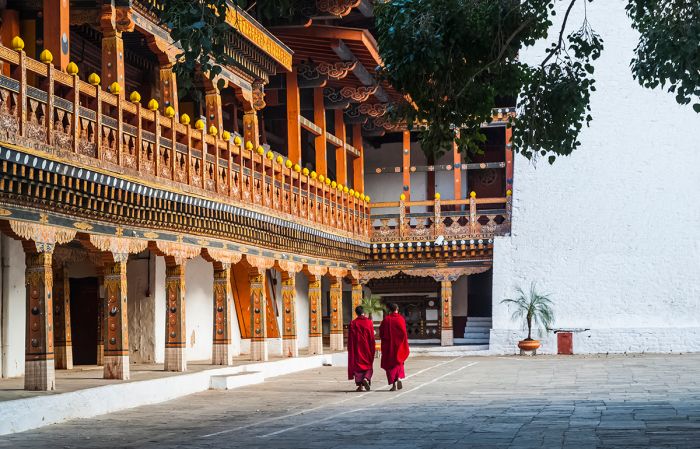
Buddhist monks at Punakha Dzong.
Central Bhutan
Central Bhutan is home to fertile valleys with herds of grazing cattle, fields of millet, buckwheat, and potatoes, evergreen forests, verdant mountains, and pristine streams with crystal-clear water flowing from glaciers. The region's deep gorges are only crossed by high-tech bridges and nail-biting roads on a few high mountain passes.
Some of the country's oldest Buddhist monasteries and temples can be seen in Central Bhutan. The quiet town of Trongsa is a must-visit, mainly to see its magnificent Trongsa Dzong, which was constructed in the during 16th-17th centuries and is situated high above the Mangde Chhu River and encircled by the Black Mountains.
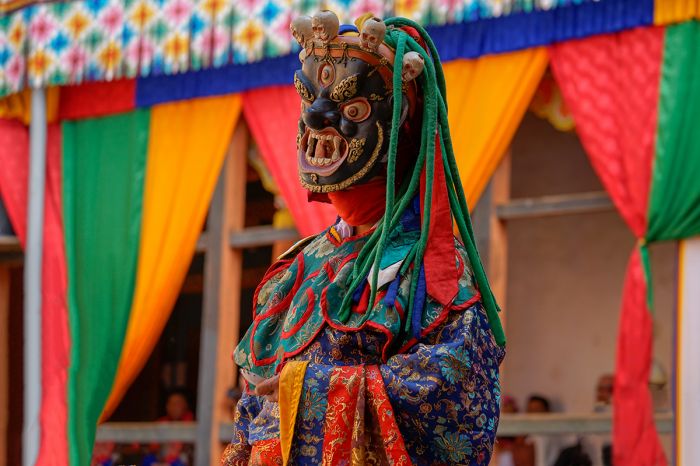
Dancer in costume at the yearly Dakar Festival in Bumthang.
The area known as Bumthang comprises the four mountain valleys of Ura, Chumey, Tang and Choekhor ("Bumthang"), although the entire district is often referred to as Bumthang Valley. The area is much-visited by tourists, who come to see its natural beauty, ancient temples, and sacred sites.
The bustling town of Jakar is a good location to base your visit to Bumthang, as it has a selection of excellent resorts, hotels, and restaurants. Bumthang also hosts a number of spectacular festivals at certain time every year; check with us for dates. Other activities include planned day hikes that offer amazing valley vistas, picnic sites, and visits to sacred sites.
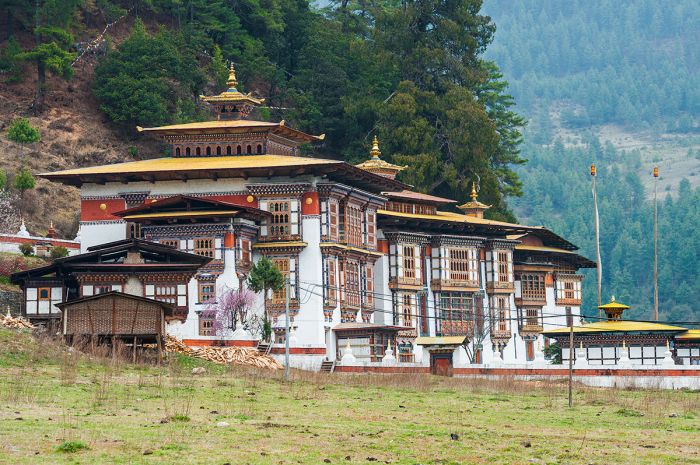
Buddhist temple in Bhumthang.
For wildlife and nature lovers, the far south of Central Bhutan offers temperate and subtropical rainforests that cover some of the country's most extraordinary topography. The region's prime destination is Royal Manas National Park, which is Bhutan's oldest national park (establish 1966).
Royal Manas is home to a great variety of mammals, including tiger, clouded leopard, elephant, water buffalo, one-horned rhino, troops of Gee's golden langur (Trachypithecus geei), and more than 350 species of bird. The park is on the border with India and is adjoined to India's Assam National Park, forming a crucial transfrontier conservation area.
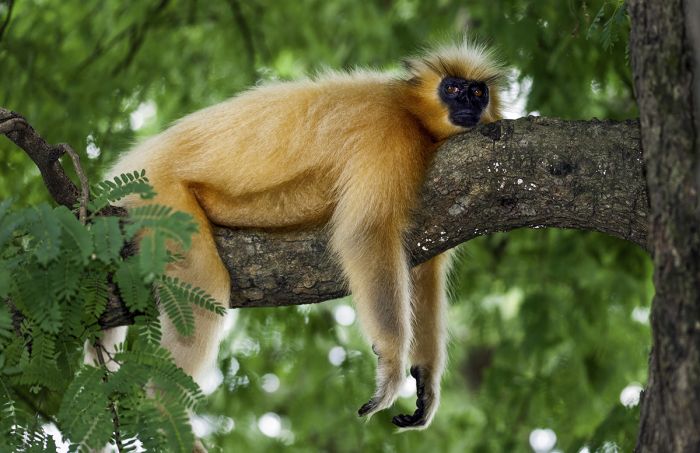
Gee's golden langur (Trachypithecus geei).
Eastern Bhutan
Eastern Bhutan is bar far the least visited of the country's three regions. It is less accessible and is characterized by rugged terrain with high mountain passes, dense forests, and traditional, uncommercialized villages. The east is really only visited by intrepid tourists, but for those willing to make the journey, is very rewarding and feels much like visiting a bygone era.
Like all of Bhutan, Eastern Bhutan offers many dzongs, monasteries, and temples and its many small settlements that are essentially uninfluenced by tourism make it a very special place to experience. The region is also the most culturally diverse. Historically, Eastern Bhutan was part of an important trade route between India and Tibet.
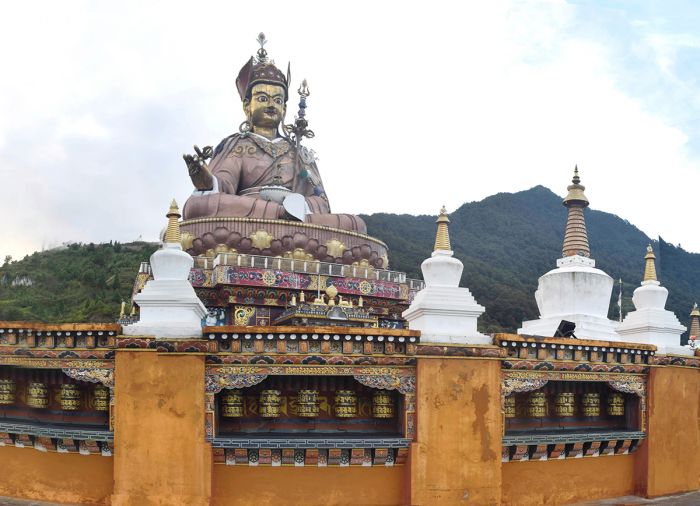
Takila statue in Lhuentse, Eastern Bhutan.
The important geographic areas of Eastern Bhutan are Monger, Lhuentse, and Trashigang.
The Mongar district sees very few visitors, with most spending a single night here before continuing on the Lhuentse or Trashigang. Mongar's original dzong, Shongar Dzong, is believed to have been constructed around 1100 and is in ruins, but can be explored. The area also offers extraordinary nature experiences, including the In Situ Rhododendron Garden, an assortment of good hiking trails, dramatic waterfalls, and spectacularly good birding.
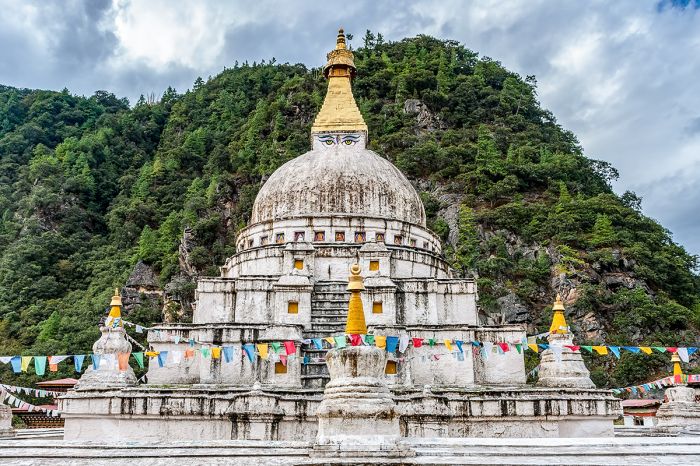
Chorten Kora in Trashiyangtse, Eastern Bhutan.
Lhuentse is remote and isolated, with picturesque mountains and valleys. The town's dzong overlooks the winding Kuri Chhu River and its valley. There are various chortens in the district. An impressive golden statue of Guru Rinpoche contains three levels of chapels in its interior. Nearby Khoma village is renowned for its traditional weaving that is so intricate that they resemble embroidery and are used to make Kiras, a traditional women's dress.
Trashigang means 'Auspicious Mountain' is an appealing town and located in the heart of Eastern Bhutan, making it a good base location for exploring in all directions. Very few people make it to Trashigang, so tourist-level accommodation is limited. There are some good scenic hiking trails nearby. The district also offers some interesting monasteries and dzongs.
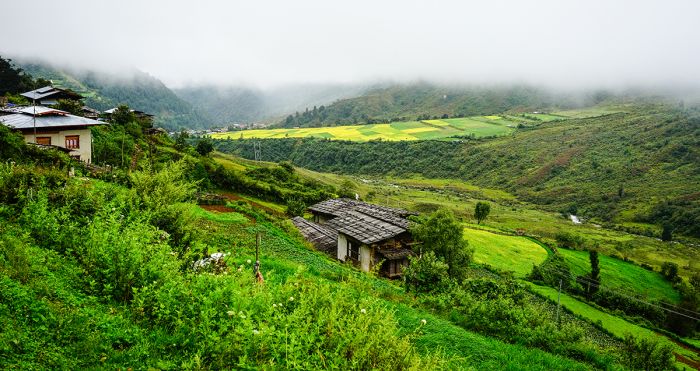
Rural houses in a small village in Eastern Bhutan.
Trekking
More than two-thirds of Bhutan is unreachable by road and is comprised of the Himalayan Mountains, rich forests and high-elevation grasslands. There is a wide range of trekking options for visitors, from relaxing and gradual-incline walks starting from small villages and through beautiful forest, to high-altitude treks in the mountains for experienced climbers only.
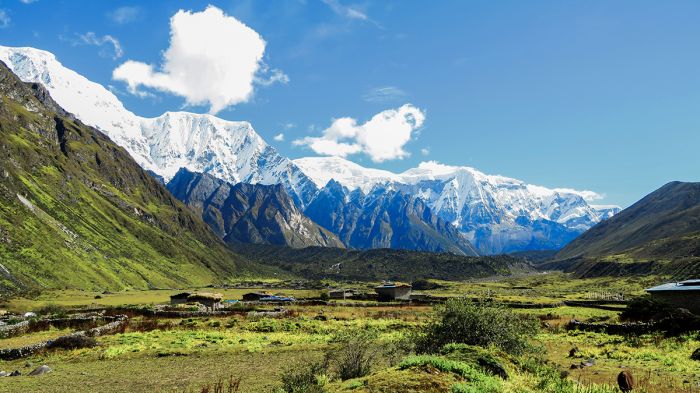
Trekking in Bhutan offers endless views of the Himalayan Mountains.
The views throughout Bhutan are generally spectacular, with rolling green pastures with grazing yaks, pristine lakes, montane forests, and snowcapped mountain backdrops. Another value-add for trekkers is that Bhutan's trails are never crowded, with most routes having less than one hundred foreigners per year. Trekkers can also be assured that their experience will be fully organized and leave all the maintenance and camping details to the guides and posters, so visitors only have to show up and enjoy the experience.
Generally, the best times to trek in Bhutan are the latter half of October and April, although this is also the peak of tourism season.
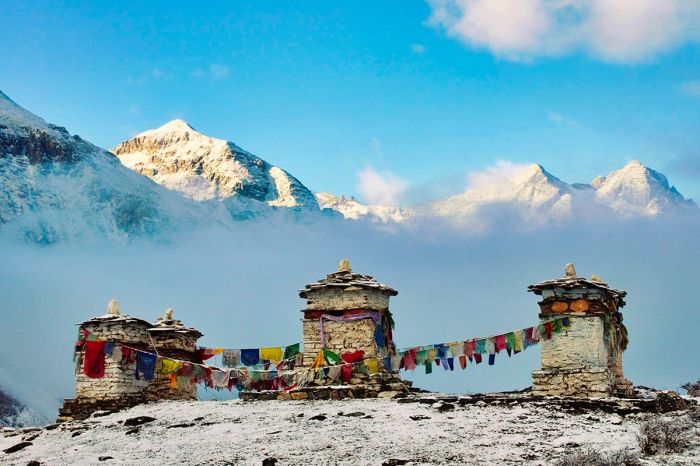
Buddhist stupas in Jomolhari base camp, Paro, Bhutan.
The following are some of the recommended treks (by region) to consider:
Western Bhutan Treks
Druk Path Trek: Paru to Thimpu. 6 days. Medium to hard difficulty. February thru May and September thru December. Max elevation: 13 894 feet.
Bumdrak Trek: Luxurious, overnight trek in Paro Valley and visits Tiger's Nest. 2 days. Medium difficulty. Mid-February thru May and September thru November. Max elevation: 12 795 feet.
Saga La Trek: Overnight trek from the Hat to Paro Valley, including superb views of Jhomolhari. 2 days. Easy difficulty. Mid-February thru May and September thru November. Max elevation: 13 123 feet.
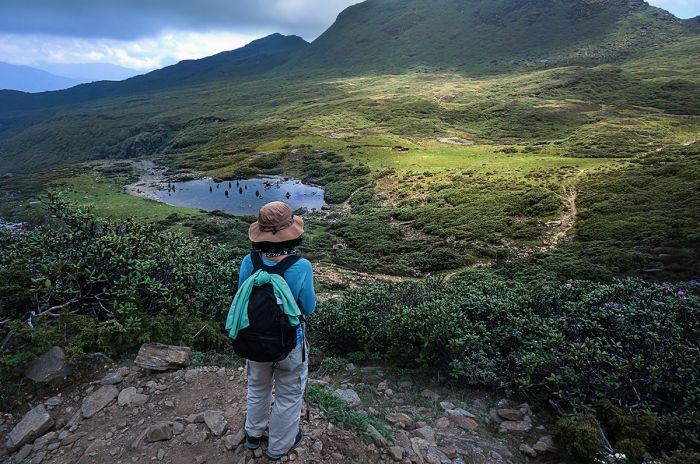
Trekking in Bhutan offers incredible scenery.
Jhomolhari Trek: Classic pilgrimage trek and the busiest route in Bhutan w/superb views of Jhomolhari. 7 days. Medium to hard difficulty. April thru June and September thru mid-November. Max elevation: 16 175 feet.
Soi Yaksa Trek: Three mountain passes, pristine montane lakes, views of Jhomolhari and to Jhomolhari base camp. 6 days. Medium difficulty. April thru June and September thru November. Max elevation: 16 043 feet.
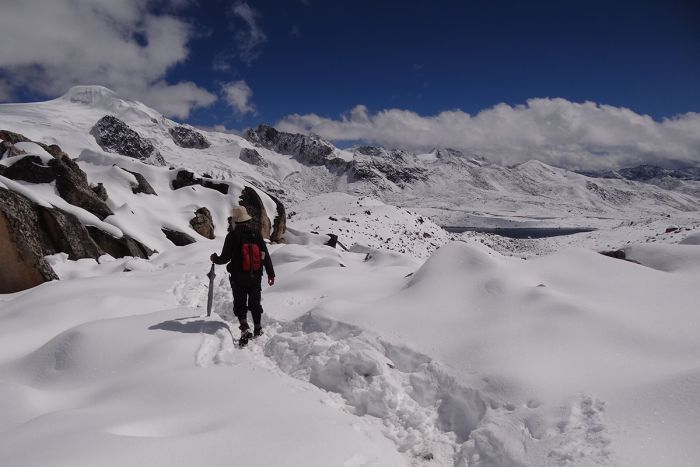
The Snowman Trek is one of the most challenging treks in Bhutan.
Laya Trek: Extended version of the Jhomolhari Trek, adding a stop in the isolated village of Laya. Possible views of takins (Budorcas taxicolor), a wild ungulate, and other diverse fauna and flora. Visits the high country along the Tibetan border. 10 days. Medium to hard difficulty. April thru June and mid-September thru mid-November. Max elevation: 16 421 feet.
Snowman Trek: Often described as the world's hardest trek. Expensive as well. Eleven mountain passes, scenery galore, mountain villages. Narrow trekking window due to weather concerns. 24-26 days. Hard difficulty. Late-September thru mid-October. Max elevation: 17 454 feet.
Dagala Thousand Lakes Trek: Mountain lake circuit south of Thimpu with extraordinary mountain scenery and little chance of seeing another trekker. 5 days. Medium difficulty. April and September thru October. Max elevation: 14 829 feet.
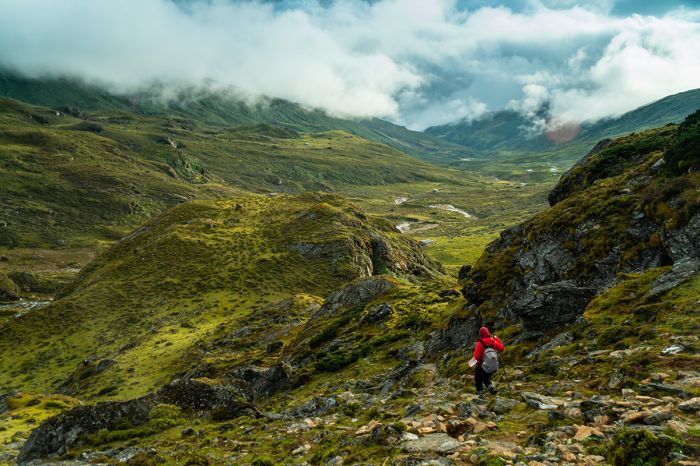
Trekking on the Thousand Lakes Trek, Dagala, Thimphu Bhutan.
Central and Eastern Bhutan Treks
Owl Trek: Explores the Bumthang region and named for the frequently-heard owls at the campsites. Panoramic mountain views, rich fir tree and rhododendron forests, high pastures with grazing yaks. 2-3 days. Medium difficulty. March thru May and October thru December. Max elevation: 12 697 feet.
Bumthang Cultural Trek: Lovely forests, beautiful lhakhangs (temples housing religious artifacts), and small villages. 1 day (optionally 2 days). Medium difficulty. March thru May and September thru November. Max elevation: 11 024 feet.
Rodang La Trek: Challenging trek across a now-abandoned trade route in Eastern Bhutan. 6-8 days. Medium to hard difficulty. October thru November. Max elevation: 13 648 feet.
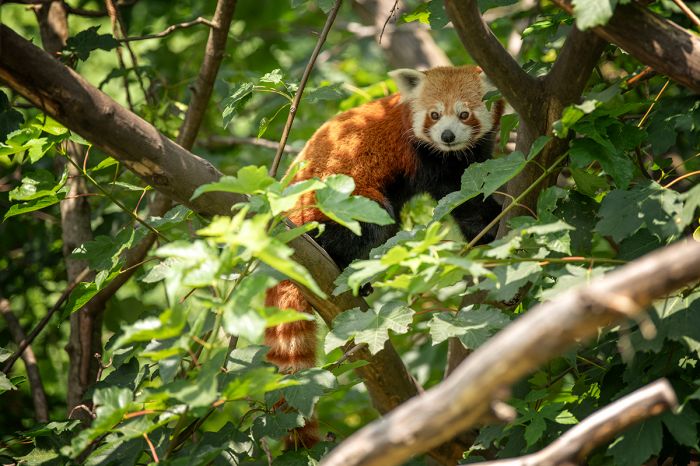
The red panda (Ailurus fulgens) can be seen on some treks in Eastern Bhutan.
Nabji Trek: Low-altitude, community-based trek involving local villagers for services and amenities. Good wildlife viewing opportunities, including golden langurs and birds. Traverses the land of the isolated Monpa people. 3-4 days. Easy difficulty. October thru March. Max elevation: 5 364 feet.
Merak-Sakteng Trek: Culture-based trek in remote, far eastern Bhutan. Passes thru the Skating Wildlife Sanctuary, which protects an unspoiled ecosystem and is home to Himalayan black bear, snow leopard, red panda, Himalayan red fox. The Brokpa people inhabit this area. 2-7 days. Medium difficulty. Mid-March thru May and September thru November. Max elevation: 11 417 feet.
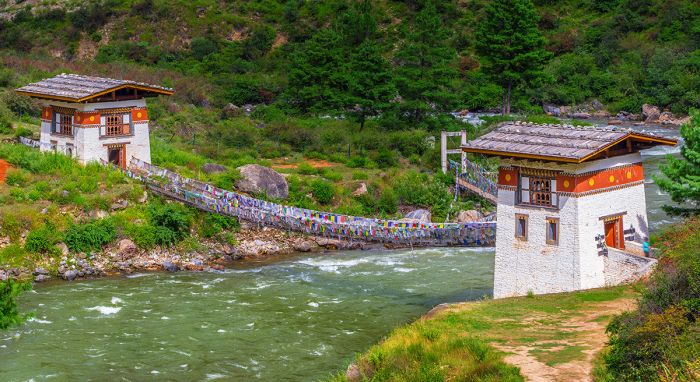
Prayer flags along a suspension bridge in Bhutan.




